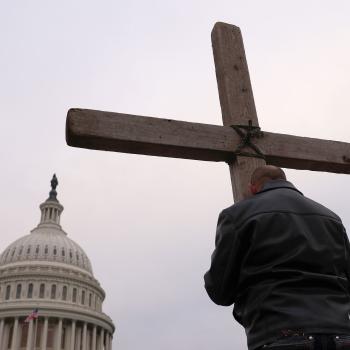Editors' Note: This article is part of the Patheos Public Square on Remembering the Dead: Ancestors, Rituals, Relics. Read other perspectives here.
"Death to the atheists!" the mob chanted, and believe it or not, they were talking about the Christians living in Smyrna in the 2nd century. I know this is a bit of a head-scratcher, but in the Roman mind, people who believed in the gods had icons. The notion of an invisible God made no sense. The notion of a crucified God was laughable.
We don't know exactly what initially got this crowd riled up. It could have been anything from boredom to an earthquake. Christians were regularly blamed for natural disasters because obviously their unbelief was angering the gods, who in turn sent earthquakes as punishment.
Fortunately, we are much more enlightened about such things today.
"Bring Polycarp!" someone else shouted, and thus the manhunt for the bishop of Smyrna began.
He wasn't hard to catch. He was eighty-six years old and power scooters hadn't been invented yet. So soon, the crowd brought him before the proconsul for questioning. Things went south fairly fast. The proconsul wanted Polycarp to deny his faith and go home, which seemed like a reasonable request. But alas, Polycarp refused. Losing his patience, the judge yelled, "Out with the atheist!"
To which Polycarp yelled back, "Yes! Out with the atheists!" And he pointed to the crowd.
Well, that didn't help.
And so Polycarp was tied to a stake on top of a pile of wood that was set on fire. Miraculously, a gust of wind bent the flames outward like a sail, so that Polycarp's flesh wasn't burnt. Instead, his body appeared like "bread that is baked," which, according to the chronicler, is much more appealing than human barbecue.
More importantly, it smelled good, which will become a hallmark of sainthood that will become popular in the Middle Ages known as odor sanctitatis or "odour of sanctity." Though instead of baked bread, the smell of flowers would be associated with the saint's body.
Frustrated with how long this was taking, the executioner approached Polycarp and stabbed him with a dagger, and out from the wound came a dove and a copious amount of blood that extinguished the fire.
Thus ended the life of Polycarp, but the Romans still weren't satisfied. They had his body tossed onto a funeral pyre until nothing was left but bones.
Members of Polycarp's church collected these relics, which they described as "more precious as the most exquisite jewels, and more purified than gold." They then "deposited them in a fitting place, whither, being gathered together, as opportunity is allowed us, with joy and rejoicing, the Lord shall grant us to celebrate the anniversary of his martyrdom."
To the best of our knowledge, this practice was the first "saint day" in which the church gathered to not only retell the saint's story, but also to hope for a miracle. The services were called a refrigerium, which will now make you view that leftover ham shank in the fridge in a completely different way. The word literally means "refreshment" and was used in conjunction with a meal that was eaten during the martyr's service, possibly in the catacombs or in a martyrium, which was a special building over the grave.
From this humble beginning, the veneration of the saints became wildly popular. Augustine defended this observance, declaring that the skeletons were "temples of faith." Honoring them was no different than honoring a living holy man because of his wisdom. Cyril of Jerusalem went even further, declaring that the corpse had an "intrinsic power" because of the "virtuous soul that once inhabited it."
As a result, a multitude of miracles were attributed not only to the remains of the saints but also to handkerchiefs or aprons that touched them, or even to the dust that collected on their tombs (see Acts 19:12 for a similar practice in the Apostolic church). This notion gave rise to the pilgrimage, where a believer in need of refreshment traveled a great distance to visit relics in the hopes that some of that power might work a much-needed miracle.
Unfortunately, this practice also gave rise to unscrupulous fraud. In the 5th century, two heads of John the Baptist appeared and yet both were accepted as credible. By the 11th century the number grew to three, and the church in Constantinople housed two of them. Guibert of Nogent attempted to bring some sanity to the issue by declaring, "Now what could be more absurd than to suppose that this great saint had two heads. Let us therefore take this matter seriously and admit that one of them is wrong."
His voice of reason fell on deaf ears. In the Middle Ages, relics became big business and sources of prestige. And zealous pilgrims sometimes got a little too enthusiastic in their venerations. For example, the "true cross" of Christ had to be removed to a look-but-don't-touch room because people were surreptitiously removing splinters with their teeth while kissing it, making it look like a chewed stump attacked by beavers.




